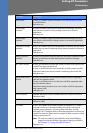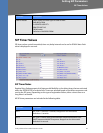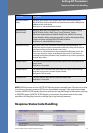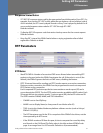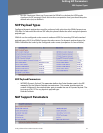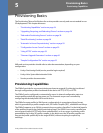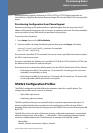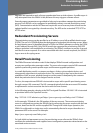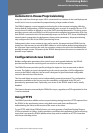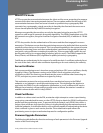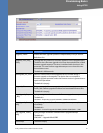
Linksys SPA9x2 Phone Administration Guide 55
SPA9x2 Configuration Profiles
Provisioning Basics
Remote firmware upgrade is achieved via TFTP or HTTP or HTTPS. Remote upgrades are
controlled by configuring the desired firmware image URL into the SPA9x2 via a remote profile
resync.
Provisioning Configuration from Phone Keypad
Remote provisioning can be performed from a phone keypad. After the user enters the IP
address of the provisioning server, the unit resyncs to a known path name. This feature enables
service providers to have VARs install and provision Linksys phones.
To provision from the phone:
1. Press Setup, then scroll to 22 Profile Rule.
2. Enter the profile rule using the following format, then press the Resync soft button.
protocol://server[:port]/profile_pathname For example:
tftp://192.168.1.5/spa942.cfg
If no protocol is specified, TFTP is assumed. If no server-name is specified, the host that requests
the URL is used as server-name.
If no port is specified, the default port is used (69 for TFTP, 80 for HTTP, and 443 for HTTPS). hen
the address can be entered in and press Resync.
Note that remote customization blink patterns use the SPA9x2 Mute button LED as follows:
• Red/orange slow blink (1.0 seconds on, 1.0 seconds off): Contacting server, server not
resolvable, not reachable, or down
• Red/orange slow blink (0.2 seconds on, 0.2 seconds off, 0.2 seconds on, 1.4 seconds off):
Server responded with file not found or corrupt file
SPA9x2 Configuration Profiles
The SPA9x2 configuration profile defines the parameter values for a specific device. The
configuration profile can be used in two formats:
• Open (XML-style) format
• Proprietary, plain-text format
The XML-style format lets you use standard tools to compile the parameters and values. To
protect confidential information contained in the configuration profile, this type of file is
generally delivered from the provisioning server to the SPA9x2 over a secure channel provided
by HTTPS.
The XML file consists of a series of elements (one per configuration parameter), encapsulated
within the element tags <flat-profile> … </flat-profile>. The encapsulated elements specify
values for individual parameters. The following is an example of a valid XML profile:
<flat-profile>
<Admin_Passwd>some secret</Admin_Passwd>



